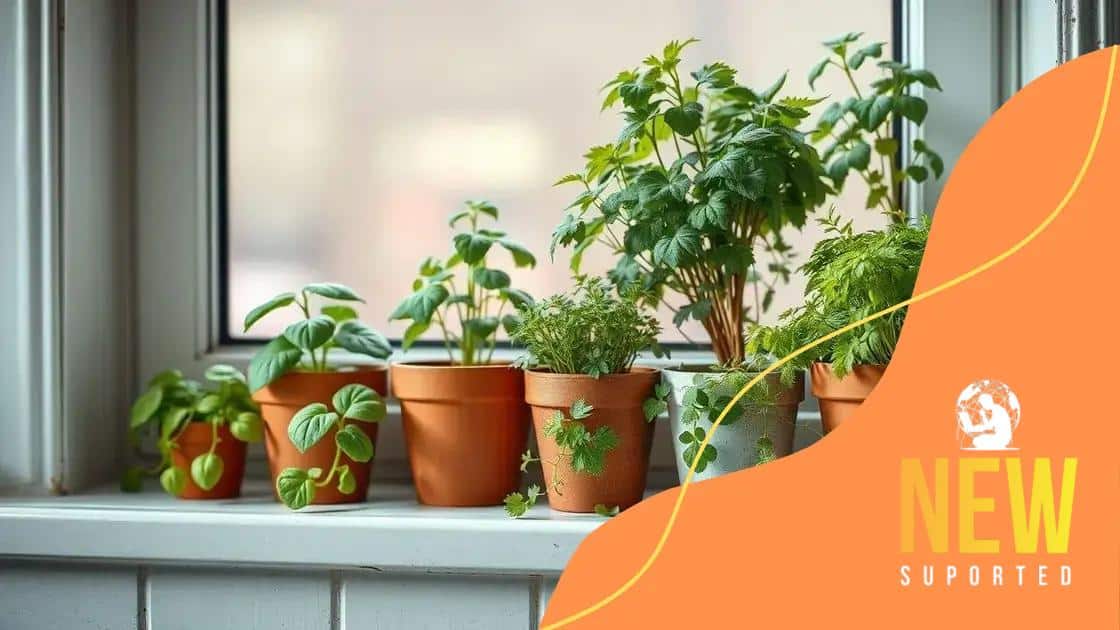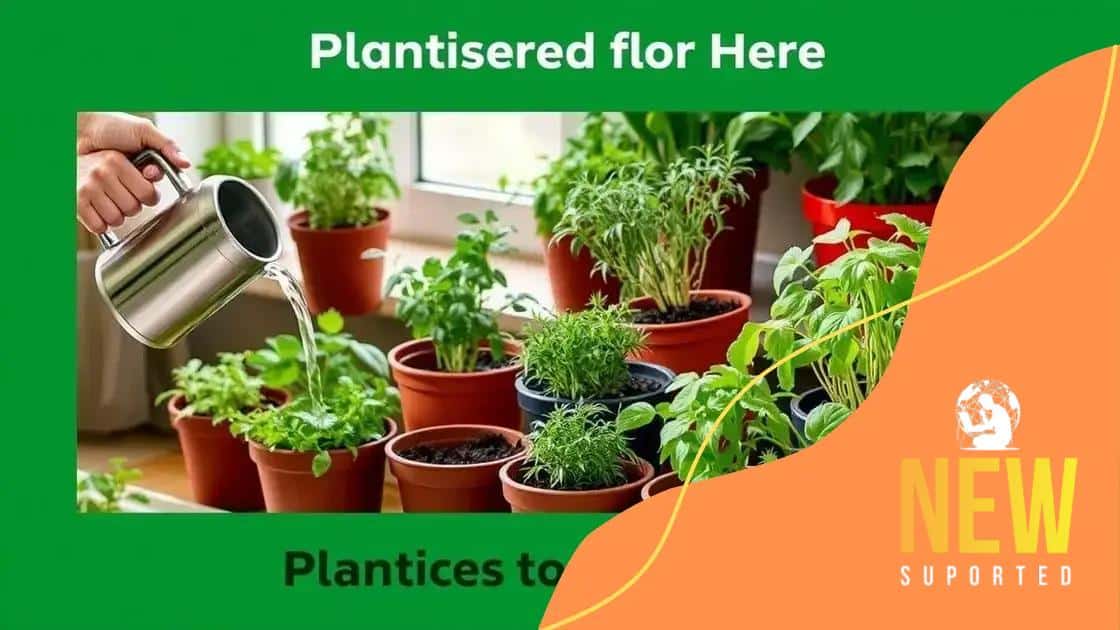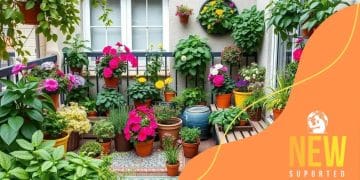How to start a herb garden in your kitchen today

To start a herb garden in your kitchen, choose easy-to-grow herbs like basil and parsley, gather essential materials, ensure proper light, and incorporate creative uses in your meals for maximum flavor.
How to start a herb garden in your kitchen? It’s easier than you might think! Imagine adding fresh flavors to meals right from your own home. Join me as we explore how to create this delightful space.
Choosing the right herbs for your kitchen
Choosing the right herbs for your kitchen is an essential step in starting a herb garden. The right selection will enhance your cooking and make your gardening experience enjoyable. Consider your cooking style and the herbs you use most often.
Top herbs to consider
When starting out, some herbs are easier to grow than others. Focus on these favorites:
- Basil – Great for Italian dishes.
- Parsley – A versatile herb that adds color and flavor.
- Mint – Refreshing and perfect for teas and desserts.
- Thyme – Ideal for seasoning meats and veggies.
These herbs thrive indoors and can easily fit into your kitchen space. Assess the amount of sunlight each area receives, as this will influence which herbs will flourish there.
Consider your preferences
Think about the types of dishes you enjoy. If you love making salads, growing cilantro or chives can be rewarding. If baking is your forte, consider rosemary or sage. Growing herbs that align with your cooking preferences will keep you motivated.
Don’t hesitate to experiment! Sometimes, unexpected choices can lead to delightful discoveries. Create a mini herb garden with a mix of flavors to enhance your culinary creations.
Essential materials for indoor gardening
When starting your indoor herb garden, having the right materials is crucial for success. The essentials will help you create a thriving environment for your herbs. Gather what you need before you begin planting.
Key materials for your herb garden
Here are some important items to consider:
- Pots – Choose pots with drainage holes to allow excess water to escape.
- Potting soil – Use high-quality soil that provides good drainage and nutrients.
- Watering can – A can with a spout allows for gentle watering.
- Gardening gloves – Protect your hands while planting and maintaining your herbs.
Having these basic supplies will set you up for success. Once you have your pots and soil ready, think about where to place them. Consider a sunny windowsill that provides at least six hours of light each day. If your space lacks natural light, consider using grow lights to ensure your herbs receive enough illumination.
Extras for enhanced growth
Now that you have the basics, consider adding a few more items. A small plant label can help you keep track of each herb. You might also want to invest in a humidity tray to maintain moisture levels, especially during dry seasons. Remember, each herb has its specific care requirements, and being prepared can make a big difference.
As you gather these materials, envision how you want your indoor garden to look. It’s not just about practicality; it can also be a beautiful addition to your kitchen.
Best practices for planting and nurturing herbs

Knowing the best practices for planting and nurturing herbs is vital for a successful indoor garden. These techniques can help ensure your herbs stay healthy and vibrant. Start with your planting method, as this sets the foundation for growth.
Planting your herbs
When you plant your herbs, follow these steps for optimal results:
- Choose the right time – Plant in spring or early summer for best growth.
- Fill pots – Use quality potting soil, filling pots to about 1 inch from the top.
- Space seeds – If planting seeds, check the recommended spacing for each herb.
- Water gently – Water the soil lightly until it’s moist but not soggy.
Once planted, don’t forget about light! Most herbs need at least six hours of sunlight daily. If natural light is limited, consider using grow lights to provide additional illumination.
Nurturing your herbs
Nurturing your herbs requires ongoing care and attention. Water them regularly, monitoring the soil moisture to avoid overwatering. You want the soil to be moist but not too wet. Each herb has specific nutrient needs, so look into fertilizing with a balanced fertilizer every few weeks during the growing season.
Watch for pests like aphids or spider mites, which can affect the health of your plants. If you spot any, act quickly by using eco-friendly pest control methods. Enjoying the process can make gardening more fulfilling. Regularly trimming your herbs encourages new growth and keeps them looking full.
Finally, be patient. Some herbs take longer to grow than others, but with the right care, you will soon have a flourishing indoor garden that enhances your culinary adventures.
Common pests and how to handle them
Common pests can be a challenge when growing your herb garden indoors. Understanding these pests and how to handle them effectively is crucial for maintaining healthy herbs. Early detection is key to preventing infestations.
Identifying common pests
Some pests are more likely to target indoor herbs. Look out for:
- Aphids – Tiny insects that suck the sap from plants.
- Spider mites – These pests leave fine webbing on leaves.
- Whiteflies – Small, white flying insects that can weaken plants.
- Mealybugs – White, cotton-like pests that cluster on stems and leaves.
Recognizing these pests early can help you take action before they cause significant damage. Regularly inspecting your plants will keep them healthy and thriving.
Effective pest control methods
When dealing with pests, there are several methods you can use to combat them naturally and effectively. Here are some strategies to consider:
- Neem oil – A natural insecticide that disrupts pest life cycles.
- Insecticidal soap – Safe for most plants, it suffocates soft-bodied insects.
- Homemade sprays – A mix of water and mild soap can help in prevention.
- Companion planting – Some plants can deter pests when grown together.
Using these methods can help maintain a pest-free environment. Always test any treatment on a small portion of the plant first to ensure it won’t cause harm.
Additionally, keeping your herbs healthy through proper watering, light, and nutrients will help them resist pests. A strong plant is less likely to be attacked, so prioritize good gardening practices.
Creative uses for your fresh herbs in meals
Using your fresh herbs creatively in meals can elevate flavors and make your dishes more exciting. Various herbs can enhance the taste of many recipes, and knowing how to incorporate them can bring your cooking to the next level.
Flavorful herb combinations
Combining herbs can create unique flavor profiles. Here are some popular pairings:
- Basil and tomato – Perfect for pasta and salads.
- Mint and lamb – A classic combination for savory dishes.
- Thyme and chicken – Adds depth to roasts and stir-fries.
- Cilantro and lime – Brightens up salsas and dressings.
Experiment with these combinations to find your favorite flavors. Fresh herbs should be added towards the end of cooking to preserve their taste, especially delicate herbs like basil and parsley.
Herbs in everyday dishes
There are countless ways to use herbs in your daily cooking. Here are some ideas:
- Salads – Toss chopped herbs into salads for an explosion of flavor.
- Soups and stews – Add herbs to soups for rich aromas.
- Sauces and dressings – Enhance sauces with freshly chopped herbs.
- Garnishes – Use herbs to top off dishes for a beautiful presentation.
With fresh herbs, you can transform simple meals into culinary masterpieces. Consider making a herb-infused oil or vinaigrette to capture the essence of your garden and use it in various dishes.
Don’t forget to experiment! Adding a sprinkle of fresh herbs at the last minute can change the flavor profile entirely, turning a standard meal into something special. Enjoy exploring all the versatile ways you can enhance your cooking with fresh herbs from your own garden.
In conclusion, starting an indoor herb garden can be both rewarding and fun. By choosing the right herbs, using essential materials, and following best practices, you can cultivate a thriving garden right in your kitchen. Remember to be aware of common pests and utilize your fresh herbs creatively in your meals. Enjoy the freshness and flavor they bring to your cooking!
FAQ – Frequently Asked Questions about Starting an Indoor Herb Garden
What are the easiest herbs to grow indoors?
The easiest herbs to grow indoors include basil, parsley, and mint. They thrive well in pots and require minimal care.
How often should I water my indoor herbs?
Water your indoor herbs when the top inch of soil feels dry, usually about once a week. Be careful not to overwater them.
Do I need special lights for my herbs?
If your herbs don’t receive enough sunlight, consider using grow lights to provide them with the necessary light they need to thrive.
Can I use fresh herbs in cooked dishes?
Yes, fresh herbs enhance flavors in cooked dishes. Add them towards the end of cooking to preserve their taste and aroma.






